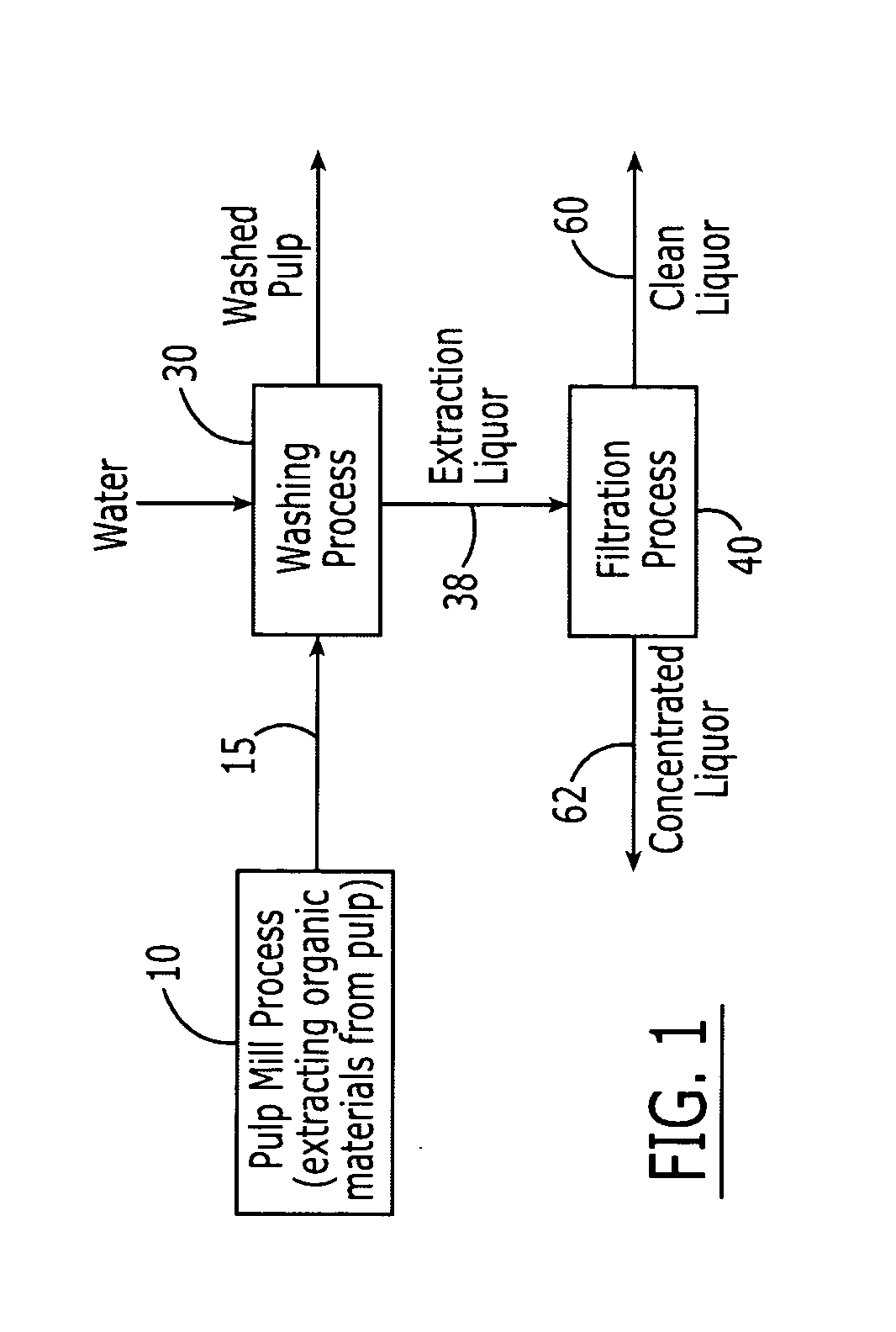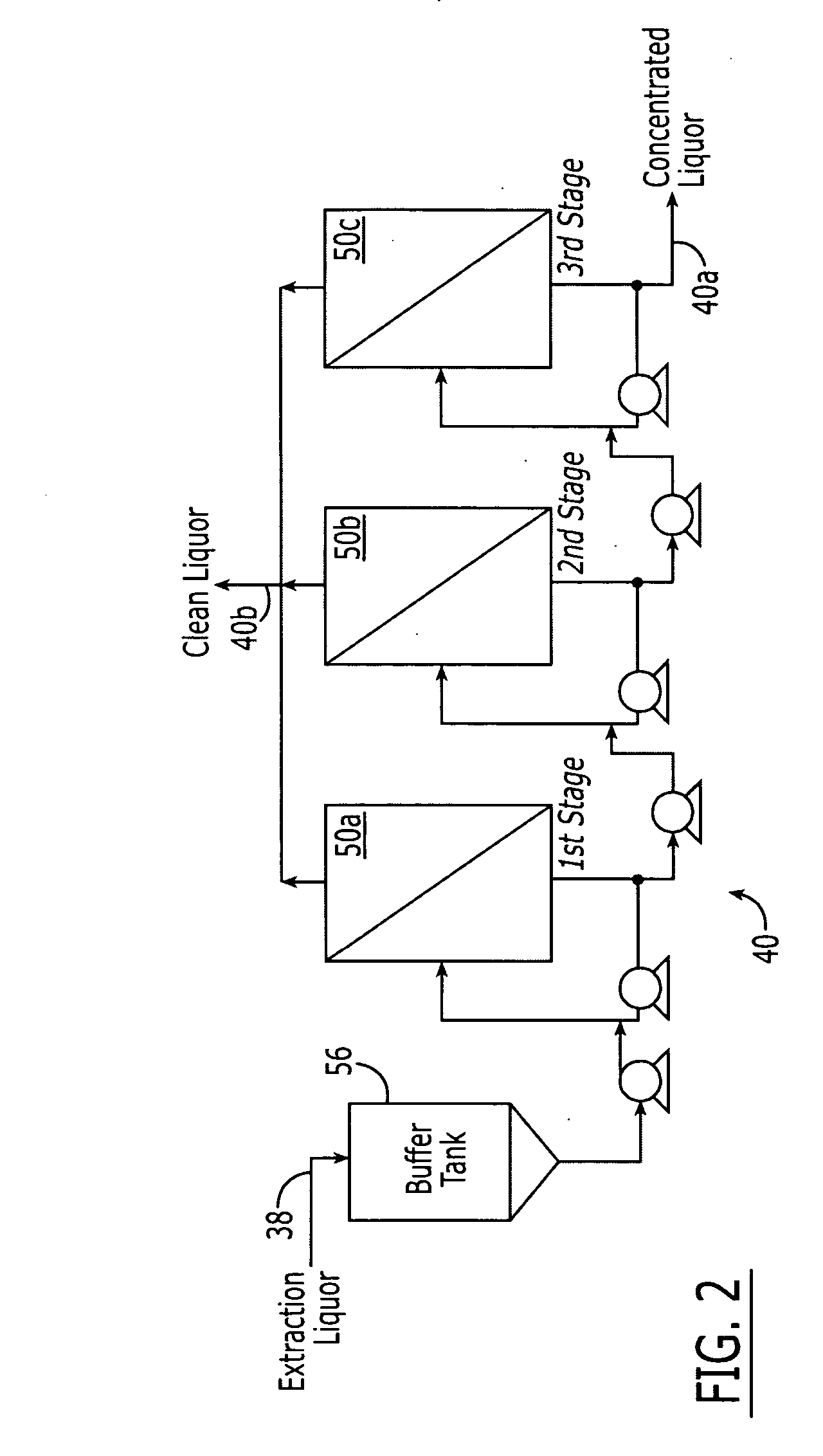Method of concentrating pulp mill extracts
a technology of pulp mill extract and concentrate, which is applied in the direction of pulp liquor regeneration, membranes, separation processes, etc., can solve the problems of large and capital intensive evaporation equipment, large bod content of bleaching waste streams, and energy-intensive evaporation of water from waste streams
- Summary
- Abstract
- Description
- Claims
- Application Information
AI Technical Summary
Benefits of technology
Problems solved by technology
Method used
Image
Examples
example 1
Removal of Water from Weak HCE Prior to Evaporation, Trial 1
[0052] A trial was undertaken to remove a large part of the water from a weak HCE feed having 8.0% solids and 68,500 mg / L of COD prior to evaporation.
[0053] The trial equipment consisted of a mobile nanofiltation trailer borrowed from Mobile Process Technology, Memphis, Tenn. The trailer used two separate filtration trains loaded with Hydranautics™ 1000 dalton nanofiltration membranes. Each of the trains consisted of five pressure vessels arranged in a 3:2 configuration (a set of 3 parallel membrane housings followed by a set of two parallel membrane housings). The pretreatment for the system consisted of 6 bag filter housings loaded with 1-25 micron bags and piped in series or parallel as needed. The HCE was cooled to below 103° F. to comply with the temperature limitations of the membranes used. The pH of the HCE was lowered to about 8 pH prior to the bag filters in order to comply with the maximum pH of the particular ...
example 2
Removal of Water from Weak HCE Prior to Evaporation, Trial 2
[0056] A trial was undertaken to remove a large part of the water from a weak HCE feed having about 6.0% solids and 4% COD prior to evaporation.
[0057] The trial equipment consisted of nanofiltation unit purchased from Crane Environment, Inc, Venice, Fla., a heat exchanger, and two prefiltration units. The unit had two separate housings, each loaded with four Koch SR3 nanofiltration membranes with molecular weight cut off of 200 daltons. The first prefiltration unit removed suspended particles larger than 40 micron, and the second removed the suspended particles larger than 5 micron. The HCE was cooled to about 110° F. to comply with the temperature limitations of the membranes used. The pH of the HCE was between 9 and 11.0.
[0058] This system allowed a feed flow of 30 to 60 gpm, and produced 10 to 25 gpm permeate flow.
[0059] Results of the COD and solids tests revealed that the membranes were rejecting 80 to 90% of the C...
PUM
| Property | Measurement | Unit |
|---|---|---|
| Pore size | aaaaa | aaaaa |
| Pore size | aaaaa | aaaaa |
| Mass | aaaaa | aaaaa |
Abstract
Description
Claims
Application Information
 Login to View More
Login to View More - R&D
- Intellectual Property
- Life Sciences
- Materials
- Tech Scout
- Unparalleled Data Quality
- Higher Quality Content
- 60% Fewer Hallucinations
Browse by: Latest US Patents, China's latest patents, Technical Efficacy Thesaurus, Application Domain, Technology Topic, Popular Technical Reports.
© 2025 PatSnap. All rights reserved.Legal|Privacy policy|Modern Slavery Act Transparency Statement|Sitemap|About US| Contact US: help@patsnap.com



